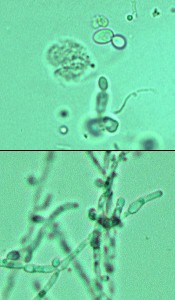|
Yeasts in unstained urine sediments are round to oval in shape, colorless, and may have
obvious budding (upper panel). They often represent contaminants, and are especially
suspect if the sample is voided and/or old.
In other circumstances, however, their significance should not be discounted. The pictures shown here, for example, are of fresh urine collected by cystocentesis from a dog that had been on long-term antibiotic and immunosuppressive therapy. The lower photo shows pseudohyphae formation by the yeasts, which were identified on culture as Candida albicans. |

|
Last Updated: January 16, 1996